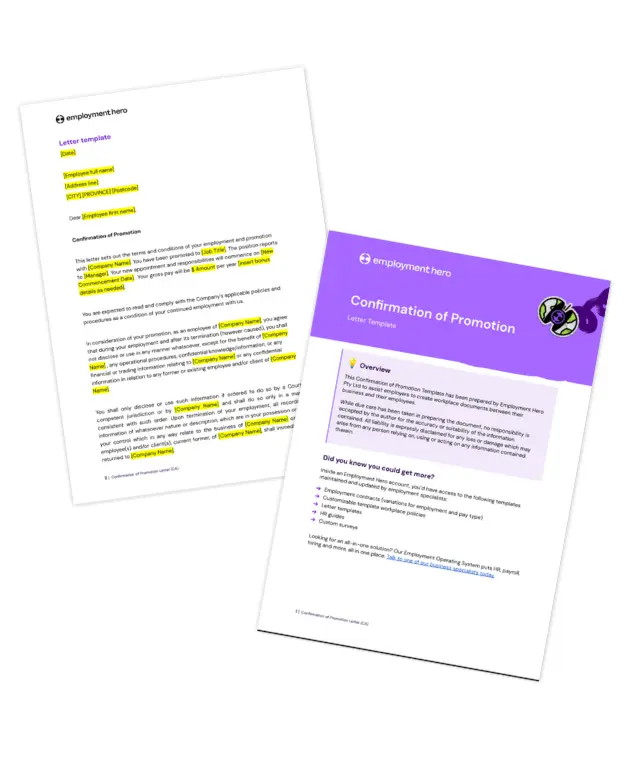Letter for a promotion: Template and writing guide
Published
Letter for a promotion: Template and writing guide
Published
Few moments are as rewarding in a manager’s career as delivering news of a job promotion. It’s a chance to celebrate an employee’s hard work, highlight their employee’s achievements and acknowledge the trust you’re placing in their future.
A promotion letter is the official record that confirms an employee’s advancement into their new position. It should reinforce that your employees are valued, set clear expectations for their additional responsibilities and ensure there’s no confusion about salary, reporting lines or the updated job title.
This guide will break down why employee promotion letters matter, what to include, how to write one and common questions. But the easiest way to put it into practice is with our ready-to-use promotion letter template. Download it now, make it your own and share the good news with your employee.

What is a promotion letter?
A promotion letter is the formal communication that confirms an employee has been moved to a new position within your organisation.
It should outline the new job title, job description or core duties, any changes in salary or benefits and adjustments to the reporting structure. The document becomes part of the employee’s record, providing both recognition of their success and clarity for payroll, HR and leadership.
Unlike a casual chat or email, this letter is part of the promotion process. It gives the promotion official weight, which is important not only for compliance but also for showing the business takes the employee’s growth seriously.

Why is writing a letter of promotion important?
A promotion letter sets the tone for the employee’s transition into a new position and helps prevent misunderstandings. Here’s why it matters:
- Clearly outlining the new job title, responsibilities and reporting line avoids any grey areas. Without this, the employee transition can be messy.
- A written record protects both the employer and employee if questions arise about the promotion process later.
- Taking the time to draft a formal letter helps employees feel valued and acknowledges their accomplishments.
- Payroll and HR teams rely on accurate letters for updates to contracts, pay and benefits.
Promotions play a big part in shaping company culture. A thoughtful employee promotion letter tells everyone that good performance, leadership skills and dedication get recognized. That message can motivate the entire team.
What to include in the letter
Your promotion letter should cover the essentials while keeping the tone encouraging. Here’s what to include:
- Employee’s current role and new role: Mention their existing job title and the new job title they are stepping into.
- Effective date: Confirm when the promotion takes effect. This is crucial for payroll and scheduling.
- New position details: Outline the job description, additional responsibilities, and any changes in reporting structure.
- Compensation changes: If the promotion includes a raise, include the new salary or note that details will be confirmed in a separate salary increase letter.
- Employee’s achievements: Highlight specific employee’s accomplishments or contributions that led to the promotion.
- Acknowledgement and gratitude: Use the letter to express appreciation and reassure the employee of the company’s continued support.
- Next steps: Indicate whether the employee needs to sign the letter, or if onboarding/training is scheduled as part of their employee transition.
Including these details in your promotion letter reduces the chance of misunderstandings around salary, reporting lines or responsibilities, while also documenting the promotion in a way that meets compliance requirements.

How to write a letter of promotion
Writing an employee promotion letter doesn’t have to be stressful. It’s part compliance, part celebration. Here’s a step by step:
Step 1: Start with the good news
Begin your letter on a positive note. Promotions are a milestone moment, and the way you frame it sets the tone. Open with a clear, celebratory statement that leaves no doubt about the employee’s achievement.
Something as simple as “We are pleased to confirm your promotion to [new job title] effective [date]” acknowledges their success and sets an uplifting tone.
Step 2: Reference the current role
Context matters. Take a moment to recognize the position they’ve held and the contribution they’ve made in that role. This not only creates a natural transition into the promotion but also reinforces that the decision is based on merit and proven performance. A quick nod to their journey so far shows that the promotion wasn’t automatic, it was earned.
Step 3: Outline the new position
Next, shift the focus to what comes next. Clearly state the new role, along with any changes to responsibilities, scope or reporting lines.
Keep this section concise but informative, you don’t need to paste in the full job description, but you should give enough detail so the employee knows what to expect. For the finer points, you can always attach a role profile or updated job description as an appendix.

Step 4: Highlight employee’s achievements
This is where you make the letter personal. Instead of keeping it generic, call out the specific achievements that led to the promotion.
That could mean mentioning measurable results, moments of leadership, or unique contributions that stood out. By making this section tailored, you show the employee that their hard work has been noticed and valued, which strengthens engagement.
Step 5: Confirm compensation details
Money and benefits are often top of mind when someone is promoted, so clarity here is key. If the promotion includes a raise, state the new salary and when it will take effect. If compensation changes are being handled separately, such as through a salary increase letter, make that clear so the employee isn’t left guessing. Transparency avoids confusion and helps maintain trust.
Step 6: Express gratitude and support
A promotion letter shouldn’t read like a transaction. It’s also a chance to say thank you. Close this section by expressing appreciation for the employee’s dedication and excitement for their future growth.
A simple line like “We would like to express our gratitude for your hard work and look forward to supporting you in this next stage of your career” helps reinforce that they’re a valued part of the team.
Step 7: Outline next steps
Finally, make sure the letter is actionable. If the employee needs to sign the letter, attend onboarding for their new role or set up a meeting with their new manager, make that clear within the letter.
Clear next steps guide the employee smoothly into their new position, and reinforces that the company is organized and ready to support their transition.

Promotion letter template
[Insert Company Name][Company Address][Date]
To: [Employee Name]Current Job Title: [Insert Current Job Title]New Job Title: [Insert New Job Title]
Dear [Employee Name],
We are delighted to confirm your job promotion to the role of [new job title], effective [date].
In this new position, your responsibilities will include [insert additional responsibilities], and you will now report to [insert reporting structure]. Your achievements, including [insert example], have demonstrated the capability, dedication and leadership that make you an excellent fit for this role.
We would like to take this opportunity to express appreciation for your contributions and express gratitude for your hard work. Please know that you have our full continued support as you step into this exciting new chapter of your career.
Sincerely,
[Manager Name][Job Title]
Save time by downloading our promotion letter template. You can simply plug in details like job title, new position, and employee’s accomplishments to create a polished, professional letter.
FAQs about promotion letters
At minimum, include the employee’s current and new job title, effective date, new position details, changes in reporting structure and a recognition of their employee’s achievements.
Some employers add full job descriptions, detailed salary breakdowns or training schedules. These aren’t mandatory but can be helpful in complex employee transitions.
If the promotion involves a phased employee transition, training program or probationary period in the new job title, include those timelines to set clear expectations.

Register for the template
Related Resources
-
 Read more: CPP, CPP2, income tax & El rates for 2026 are here
Read more: CPP, CPP2, income tax & El rates for 2026 are hereCPP, CPP2, income tax & El rates for 2026 are here
Get the latest CPP, CPP2, income tax & EI rates for 2026 in one simple cheatsheet. Stay compliant, avoid CRA…
-
 Read more: Bringing on new hires in the New Year? Here’s the checklist that makes onboarding smooth and stress-free.
Read more: Bringing on new hires in the New Year? Here’s the checklist that makes onboarding smooth and stress-free.Bringing on new hires in the New Year? Here’s the checklist that makes onboarding smooth and stress-free.
Your Canada-specific guide and checklist for onboarding new hires in 2026. Get first-day essentials, setup steps and a full 30-60-90…
-
 Read more: Tax package prep stressing you out? Here’s the checklist that makes it simple.
Read more: Tax package prep stressing you out? Here’s the checklist that makes it simple.Tax package prep stressing you out? Here’s the checklist that makes it simple.
A clear, step-by-step checklist guide to preparing T4s and getting CRA-ready. Learn what documents to gather and avoid common filing…


















